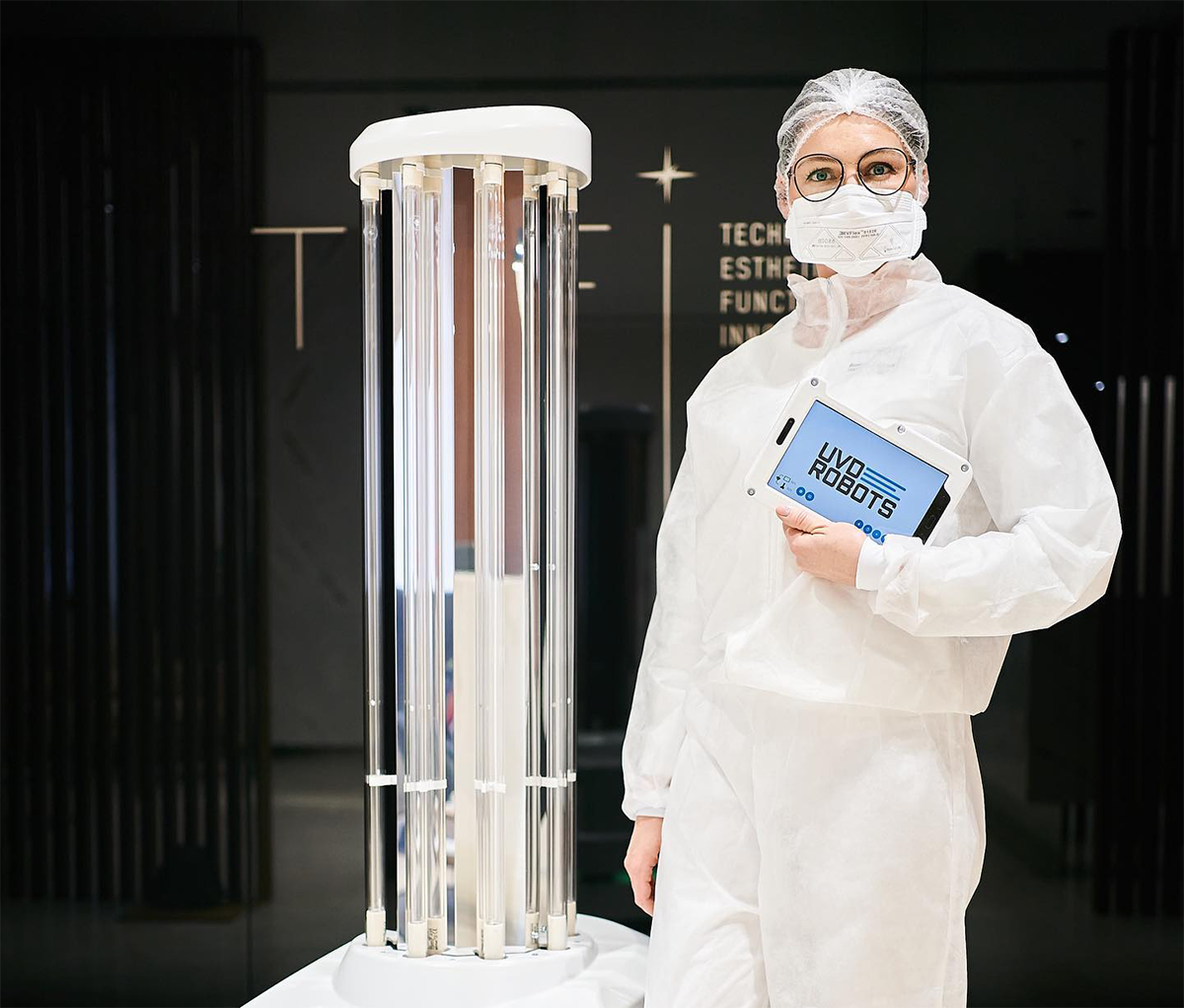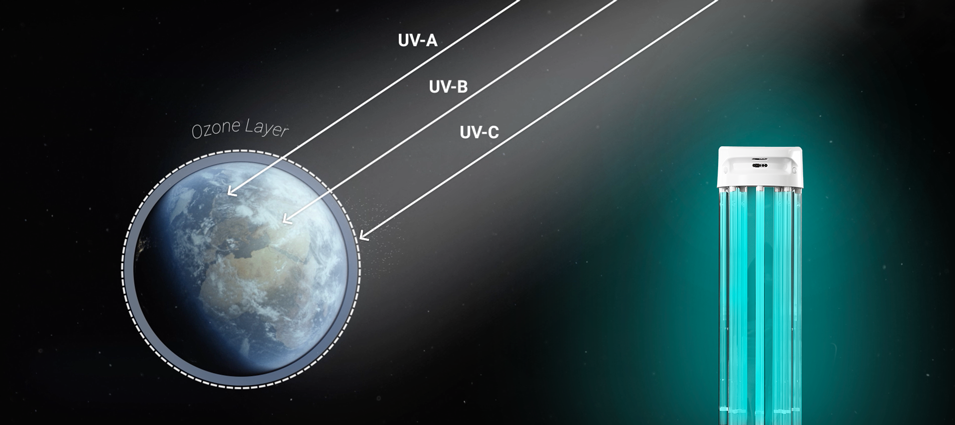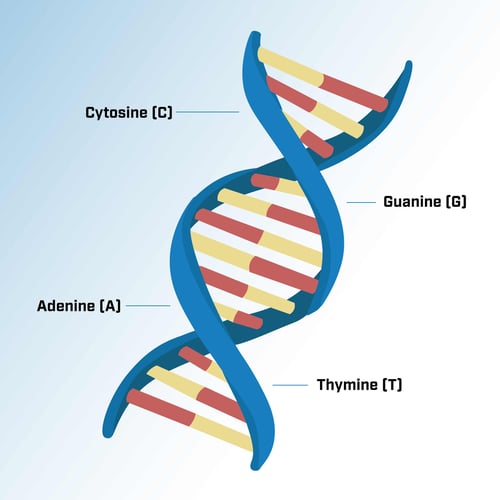Title
Content
Title
Content

Ultraviolet C, or UV-C light, exposure has been associated with the reduction of microorganisms on surface areas.1 But how exactly does UV-C light inactivate them? Let’s take a closer look at the process.
Ultraviolet, or UV light, is a type of radiation that is part of the electromagnetic spectrum. It is invisible to the human eye and its wavelengths range from 100 to 400 nanometers (nm).2
UV light can be of lower frequencies, or with long wavelengths of 280 to 400 nm. This type of UV light is known as Ultraviolet A and Ultraviolet B (UV-A and UV-B) light. Higher-frequency UV light, with shorter wavelengths of 100 to roughly 200 nm, is known as vacuum UV light.3
Ultraviolet C (or UV-C) light is a type of UV light that has wavelengths that range from 200 nm to 280 nm.4 5
 UV-C light waves are comprised of photons, or particles of light. They are the most energetic of the optical electromagnetic spectrum (comprised of UV, visible, and infrared light) and are, therefore, the most photochemically active.
UV-C light waves are comprised of photons, or particles of light. They are the most energetic of the optical electromagnetic spectrum (comprised of UV, visible, and infrared light) and are, therefore, the most photochemically active.
UV-C light occurs in natural sunlight, but it is blocked by the atmosphere and does not reach the earth’s surface. UV-C light, however – especially at wavelengths of 254 nm – can be replicated in the form of UV lamps, and these UV-C lamps can be used in environmental disinfection procedures.6
These procedures are intended to be antimicrobial in nature. Indoor surfaces exposed to 254 nm UV-C light, for example, have been found to have fewer microorganisms than surfaces without such exposure, according to several studies.7 8 9 For this reason, UV-C light has been associated with decreased levels of surface microorganisms and is also known as ultraviolet germicidal irradiation, or UVGI.10
UV-C light has been associated with reductions of microorganisms in liquids,11 on surfaces,12 and even in the air.13 Though the way UV light interacts with these microorganisms is not entirely clear, disinfection is thought to be associated with the molecular breakdown of nucleic acids.14
All living organisms contain nucleic acids, which themselves are polymers, or large groups of repeating molecules.15 Nucleic acids are essential components of all life forms and appear as deoxyribonucleic acid (DNA) and/or ribonucleic acid (RNA) in microorganisms and larger life forms.16

DNA and RNA, as nucleic acids, are themselves comprised of molecular compounds. DNA contains the nitrogen-containing compounds:
In terms of environmental effects, the presence of 254 nm UV-C light has been associated with a degeneration of nucleic acids – such as DNA and RNA. In DNA specifically, UV-C light seems to start a reaction between molecules of thymine, creating thymine dimers.19 Thymine dimers are essentially components of thymine that have been broken down into two parts.20
Normally, a microorganism's repair process will remove thymine dimers and replace them, to once again form an intact DNA strand.21 With prolonged exposure to UV-C light, however, there is a greater chance that the replacement process will go wrong.
An inhibited thymine replacement process will create damaged cellular DNA – DNA that cannot be adequately repaired.22 In this way, UV-C light exposure has the potential to cause a debilitative reaction in all types of organisms. On a smaller scale, the damaged cellular DNA will cause death among exposed microorganisms.23
Indeed, some studies have shown that devices emanating 254 nm UV-C light can reduce microorganisms at rates of over 99.9%.24 25 In terms of logarithmic ratios that describe contamination levels, this rate would represent an over 3-log reduction in environmental microorganisms.
UVD Robots (with UVD standing for Ultraviolet Disinfection Robots), are self-driving UVGI disinfection robots. UVD Robots are developed and produced by the Danish company Blue Ocean Robotics, and use 254 nm UV-C light for environmental disinfection purposes.26
As self-navigating robots, UVD Robots are able to irradiate indoor environments with UV-C light in multiple areas, more so than stationary systems.27 UVD Robots, as mobile UV-C devices, are capable of over 3-log reductions of microorganisms, or an efficacy rate of over 99.9%. 28 29
The presence of UV-C light has been associated with environmental microorganism reduction, and its effects appear to initiate on a molecular level.
There may be an association between exposure to UV light and deterioration of nucleic acids, notably of the DNA compound thymine. This deterioration appears to happen when damage to the thymine compounds occurs faster than they can be repaired.
UVD Robots are mobile disinfection robots that emit 254nm UV-C light. As autonomous robots, they are especially potent against several environmental microorganisms and can reduce them at efficacy rates of 99.99%.
Lorem ipsum dolor sit amet, consectetur adipiscing elit, sed do eiusmod tempor incididunt ut labore et dolore magna aliqua.
1. Andersen, Helle Stendahl. Analysis Report: Test of UV Disinfection Robot acc. NF T72-281. Report Number 754372_Rev. 2. Danish Technological Institute, 2020.
2. Illuminating Engineering Society. “IES Committee Report CR-2-20 FAQs.” Illuminating Engineering Society, 7 Mar. 2022, www.ies.org/standards/committee-reports/ies-committee-report-cr-2-20-faqs.
3. Illuminating Engineering Society. “IES Committee Report CR-2-20 FAQs.” Illuminating Engineering Society, 7 Mar. 2022, www.ies.org/standards/committee-reports/ies-committee-report-cr-2-20-faqs.
4. Illuminating Engineering Society. “IES Committee Report CR-2-20 FAQs.” Illuminating Engineering Society, 7 Mar. 2022, www.ies.org/standards/committee-reports/ies-committee-report-cr-2-20-faqs.
5. BELULİ, Valdrin. "Intermediate Formation of Essential Amino Acids and Division of Amine (NH2) Group by UV Light as Sterilizer in Vegetables (ISO 15714: 2019)." Journal of Nuclear Sciences 6.2 (2020): 34-43.
6. Kowalski, Wladyslaw. Ultraviolet germicidal irradiation handbook: UVGI for air and surface disinfection. Springer science & business media, 2010.
7. Andersen, Helle Stendahl. Analysis Report: Test of UV Disinfection Robot acc. NF T72-281. Report Number 754372_Rev. 2. Danish Technological Institute, 2020.
8. Edwards-Jones, Val. "Assessment of UVD Robot Against Reduction of MultiDrug Resistant Klebsiella pneumoniae, Acinetobacter baumannii and Clostridium difficile on Surfaces." Essential Microbiology Ltd. and Melbec Microbiology Ltd., Apr. 2019, www.melbecmicrobiology.co.uk, www.essentialmicrobiology.com.
9. Kowalski, Wladyslaw. Ultraviolet germicidal irradiation handbook: UVGI for air and surface disinfection. Springer science & business media, 2010.
10. Kowalski, Wladyslaw. Ultraviolet germicidal irradiation handbook: UVGI for air and surface disinfection. Springer science & business media, 2010.
11. Song, Kai, Madjid Mohseni, and Fariborz Taghipour. "Application of ultraviolet light-emitting diodes (UV-LEDs) for water disinfection: A review." Water research 94 (2016): 341-349.
12. Andersen, Helle Stendahl. Analysis Report: Test of UV Disinfection Robot acc. NF T72-281. Report Number 754372_Rev. 2. Danish Technological Institute, 2020.
13. Guillard, Chantal, et al. "Microbiological disinfection of water and air by photocatalysis." Comptes Rendus Chimie 11.1-2 (2008): 107-113.
14. Boyce, Richard P., and Paul Howard-Flanders. "Release of ultraviolet light-induced thymine dimers from DNA in E. coli K-12." Proceedings of the National Academy of Sciences 51.2 (1964): 293-300.
15. Pauling, Linus, and Robert B. Corey. "A proposed structure for the nucleic acids." Proceedings of the National Academy of Sciences 39.2 (1953): 84-97
16. Weintraub, Harold M. "Antisense rna and dna." Scientific American 262.1 (1990): 40-47.
17. Ghosh, Prahlad C. "Nucleotide metabolism." 2008.
18. Surova, O., and B. Zhivotovsky. "Various modes of cell death induced by DNA damage." Oncogene 32.33 (2013): 3789-3797
19. Pathak, M. A., D. M. Krämer, and U. Güngerich. "Formation of thymine dimers in mammalian skin by ultraviolet radiation in vivo." Photochemistry and Photobiology 15.2 (1972): 177-185.
20. Pinak, Miroslav. "Enzymatic recognition of radiation-produced oxidative DNA lesion. Molecular dynamics approach." Modern Methods for Theoretical Physical Chemistry of Biopolymers. Elsevier Science, 2006. 191-210.
21. Kao, Ya-Ting, et al. "Direct observation of thymine dimer repair in DNA by photolyase." Proceedings of the National Academy of Sciences 102.45 (2005): 16128-16132.
22. Setlow, Richard B., and Jane K. Setlow. "Evidence that ultraviolet-induced thymine dimers in DNA cause biological damage." Proceedings of the National Academy of Sciences 48.7 (1962): 1250-1257.
23. Rammelsberg, Anne. “How does ultraviolet light kill cells?” Scientific American, 17 Aug. 1998, https://www.scientificamerican.com/article/how-does-ultraviolet-ligh/.
24. Andersen, Helle Stendahl. Analysis Report: Test of UV Disinfection Robot acc. NF T72-281. Report Number 754372_Rev. 2. Danish Technological Institute, 2020.
25. Edwards-Jones, Val. "Assessment of UVD Robot Against Reduction of MultiDrug Resistant Klebsiella pneumoniae, Acinetobacter baumannii and Clostridium difficile on Surfaces." Essential Microbiology Ltd. and Melbec Microbiology Ltd., Apr. 2019, www.melbecmicrobiology.co.uk, www.essentialmicrobiology.com.
26. González, Carlos M. "Cleaning with UV light." Mechanical Engineering 143.1 (2021): 32-33.
27. Zeldovich, Lina. "The Robot Will See You Now." Mechanical Engineering 142.06 (2020): 34-39.
28. Andersen, Helle Stendahl. Analysis Report: Test of UV Disinfection Robot acc. NF T72-281. Report Number 754372_Rev. 2. Danish Technological Institute, 2020.
29. Edwards-Jones, Val. "Assessment of UVD Robot Against Reduction of MultiDrug Resistant Klebsiella pneumoniae, Acinetobacter baumannii and Clostridium difficile on Surfaces." Essential Microbiology Ltd. and Melbec Microbiology Ltd., Apr. 2019, www.melbecmicrobiology.co.uk, www.essentialmicrobiology.com.